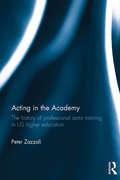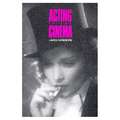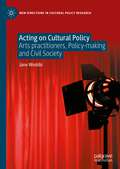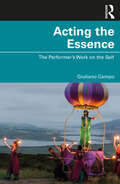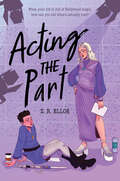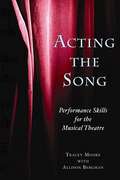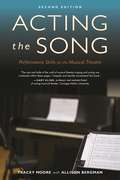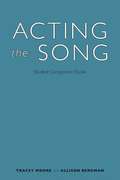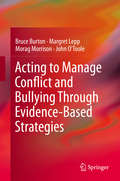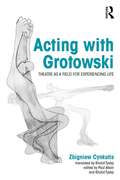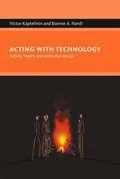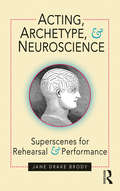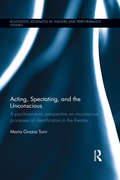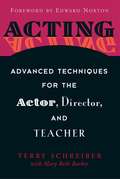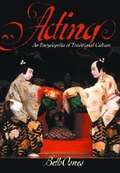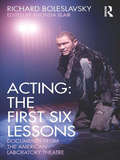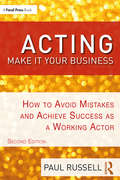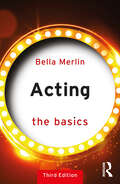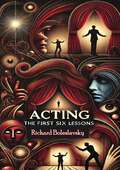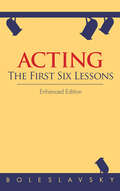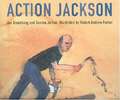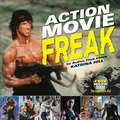- Table View
- List View
Acting in the Academy: The History of Professional Actor Training in US Higher Education
by Peter ZazzaliThere are over 150 BFA and MFA acting programs in the US today, nearly all of which claim to prepare students for theatre careers. Peter Zazzali contends that the curricula of these courses represent an ethos that is as outdated as it is limited, given today’s shrinking job market for stage actors. Acting in the Academy traces the history of actor training in universities to make the case for a move beyond standard courses in voice and speech, movement, or performance, to develop an entrepreneurial model that motivates and encourages students to create their own employment opportunities. This book answers questions such as: How has the League of Professional Theatre Training Programs shaped actor training in the US? How have training programmes and the acting profession developed in relation to one another? What impact have these developments had on American acting as an art form? Acting in the Academy calls for a reconceptualization of actor training the US, and looks to newly empower students of performance with a fresh, original perspective on their professional development.
Acting in the Cinema
by James NaremoreJames Naremore focuses on the work of film acting, showing what players contribute to movies. Ranging from the earliest short subjects of Charles Chaplin to the contemporary features of Robert DeNiro, he develops a useful means of analyzing performance in the age of mechanical reproduction.
Acting on Cultural Policy: Arts Practitioners, Policy-Making and Civil Society (New Directions in Cultural Policy Research)
by Jane WoddisThis book investigates the role of arts practitioners in cultural policy-making, challenging the perception that arts practitioners have little or no involvement in policy and seeking to discover the extent and form of their engagement. Examining the subject through a case-study of playwriting policy in England since 1945, and paying particular attention to playwrights’ organisations and their history of self-directed activity, the book explores practitioners’ participation in cultural policy-making, encompassing both “invited” and “uninvited” interventions that also weave together policy activity and creative practice. It discusses why their involvement matters, and argues that arts practitioners and their organisations can be understood as participants in civil society whose policy activity contributes to the maintenance and enlargement of democratic practices and values.
Acting the Essence: The Performer's Work on the Self
by Giuliano CampoActing the Essence examines the theory, practice, and history of the art of the performer from the perspective of its inner nature as work on oneself, within, around, and beyond the pedagogy of the actor. Ref lecting primarily on the legacy of Jerzy Grotowski, this book is composed of a series of ref lections on the Stanislavskian lineage of practitioners and related authors, in an attempt to revive awareness of the original path traced by the Russian master and to refine certain ambiguities in contemporary training. In a new media age of image and sound, accompanied by a proliferation of new technologies and means to communicate, emphasised by the COVID-19 crisis, a classic question comes to be asked of us again: What is the essence and the principal objective of the work of the performer? Is performing art still necessary? While proposing a theoretical advancement of the discipline and an historical overview of the relevant practices, this book provides tools for a better understanding of the traditional function of the performer’s practice as work on the self, for its ecological renaissance through a conscient use of trance, attention, and altered states of consciousness. This book offers insight for students in drama, theatre, and performance courses studying acting and performance at university.
Acting the Part
by Z.R. EllorThis delightfully tropey teen romance perfect for fans of Ashley Poston and Lyla Lee follows a queer teen actor navigating their gender identity—while pretending to date their co-star. Queer actor Lily Ashton has found fame playing lesbian warrior Morgantha on the hit TV show Galaxy Spark. Lily knows how little representation queer girls have, so when the showrunners reveal that Morgantha’s on-screen love interest, Alietta, is going to be killed off, Lily orchestrates an elaborate fake-dating scheme with the standoffish actress who plays her, to generate press and ensure a happy ending for the #Morganetta ship.But while playing a doting girlfriend on- and off-screen, Lily struggles with whether a word like “girl” applies to them at all.Lily’s always been good at playing a part. But are they ready to share their real self, even if it means throwing everything they’ve fought for away?
Acting the Song: Performance Skills for the Musical Theatre
by Tracey Moore Allison BergmanActing the Song offers a contemporary, integrated approach to singing in musicals that results in better-trained, smarter performers who can use song to add drama and dimension to their roles. Directors, teachers of musical theater, and students--including actors, singers, or dancers--will find time-tested advice, exercises and worksheets for all skill levels. This book guides readers through musical theater elements, classroom workshops, and the world of professional auditions and performances. Chapters cover vocal and physical warm-ups, body movement, finding subtext, creating a character, song structure, interpreting text of music and lyrics, risks and spontaneity, memorization, collaboration, keeping a performance fresh, and much more. Both teachers and students will appreciate the sections for beginning, intermediate, and advanced performers. Everyone involved in musical theater, from new students to working professionals, will benefit from this rich resource.
Acting the Song: Performance Skills for the Musical Theatre
by Tracey Moore Allison BergmanActing the Song offers a contemporary, integrated approach to singing in musicals that results in better-trained, smarter performers everyone wants to work with. In this new, thoroughly updated edition of the paperback, directors and teachers of musical theater will find guidance in developing and leading musical theater elements, classroom workshops, and the world of professional auditions and performances. A companion ebook specifically for students-including actors, singers, or dancers-contains time-tested advice, exercises, and worksheets for all skill levels, with links to additional resources online. Subjects for both versions cover:Singing and acting terminologyUse of microphones, recording devices, and other technologyVocal and physical warm-ups, movements, and gesturesCreating a characterFinding subtext, interpreting music and lyrics, and song structureCollaborating with other actorsKeeping a performance fresh and newUsing social media and online audition sitesTeachers and students alike will appreciate the sections for beginning, intermediate, and advanced performers. Covering all changes to the industry, education, music styles, and audition protocols, everyone involved in musical theater, from new students to working professionals, will benefit from this rich resource.Allworth Press, an imprint of Skyhorse Publishing, publishes a broad range of books on the visual and performing arts, with emphasis on the business of art. Our titles cover subjects such as graphic design, theater, branding, fine art, photography, interior design, writing, acting, film, how to start careers, business and legal forms, business practices, and more. While we don't aspire to publish a New York Times bestseller or a national bestseller, we are deeply committed to quality books that help creative professionals succeed and thrive. We often publish in areas overlooked by other publishers and welcome the author whose expertise can help our audience of readers.
Acting the Song: Student Companion Ebook
by Tracey Moore Allison BergmanUsed in tandem with Acting the Song: Performance for the Musical Theatre, this Student Companion Ebook guides students through three semesters (beginning, intermediate, and advanced) of musical theatre song study. It answers the many questions students using this method may have, including some that they may be reluctant to ask-about fear, handling criticism, understanding their type, dealing with bad auditions, and the best use of social media, among others. Worksheets completed by real-life students can be used as models of best practice and will serve to inspire students to dig deeply and explore their own thoughts about the songs.Teachers using Acting the Song will find this ebook companion indispensable, and students will come to class more prepared, ready to work, and more open to learning.
Acting to Manage Conflict and Bullying Through Evidence-Based Strategies
by Bruce Burton Margret Lepp Morag Morrison John O'TooleThis book offers a complete and detailed account of the evolution of an internationally successful, evidence-based program that has been the result of almost two decades of action research into conflict and bullying. It addresses one of the most serious problems encountered in schools and work places worldwide: that of bullying and inter-personal conflict. The book presents a comprehensive account of the research, development and refinement of the DRACON Project and the Acting Against Bullying and Cooling Conflicts programs. The effective strategies that emerged from the extensive international research and practice use a combination of theories of conflict and bullying management with drama techniques and peer teaching which have been unique in their application. The book analyses their evolution into an effective program that has impacted positively on bullying and conflict in a number of settings. In the UK the program successfully addressed behavioural problems amongst girls in schools through the use of peer teaching in a drama setting. In Sweden the program assists nursing students, nurses and other health professionals to deal with conflict in the workplace. In Australia it has been applied in hundreds of schools to reduce bullying and assist newly arrived refugees to deal with cultural conflict and develop resilience and self- identity in their new country. This volume makes a major and authentic contribution to the international effort to find effective strategies and techniques to deal with interpersonal conflict and bullying across a range of contexts.
Acting with Grotowski: Theatre as a Field for Experiencing Life
by Zbigniew Cynkutis‘Zbigniew Cynkutis’ writings constitute invaluable testimony of his work with Jerzy Grotowski during the ‘theatre of productions’ phase and beyond. Cynkutis’ insights elucidate aspects of the Laboratory Theatre’s praxis and provide a unique perspective on the questions most often asked about Grotowski. Authored by one of the Laboratory Theatre’s most accomplished actors, this book draws on long-term theatre research and deep knowledge of the craft of acting to offer practical advice indispensable to the professional and aspiring actor alike. The volume offers the English-speaking reader an unprecedented richness of primary source material, which sheds new light on the practical work of one of the most influential theatre directors of the 20th century. Cynkutis’ voice is sincere and direct, and will continue to inspire new generations of theatre practitioners.’ – Dominika Laster, Yale University Acting with Grotowski: Theatre as a Field for Experiencing Life explores the actor-director dynamic through the experience of Zbigniew Cynkutis, one of Polish director Jerzy Grotowski’s foremost collaborators. Cynkutis’s work as an actor, combined with his later work as a director and theatre manager, gave him a visionary overview based on precise embodied understanding. Cynkutis’s writings yield numerous insights into the commitment needed to make innovative, challenging theatre. A central component of Acting with Grotowski is his distinctive approach to training: ‘Conversations with the Body’ includes a range of techniques and approaches to warming up, rehearsing and creating work from a physical starting point, beautifully illustrated by Bill Ireland. The book comprises reflections and practical suggestions on a range of subjects – theatre and culture, improvisation, ethics, group dynamics, and Cynkutis’s vision for the Wrocław Second Studio. It contains visual and textual materials from Cynkutis’s own private archive, such as diary entries and letters. Acting with Grotowski demonstrates the thin line that separates life and art when an artist works with extreme commitment in testing political and social conditions.
Acting with Technology: Activity Theory and Interaction Design
by Victor Kaptelinin Bonnie A. NardiActivity theory holds that the human mind is the product of our interaction with people and artifacts in the context of everyday activity. Acting with Technology makes the case for activity theory as a basis for understanding our relationship with technology. Victor Kaptelinin and Bonnie Nardi describe activity theory's principles, history, relationship to other theoretical approaches, and application to the analysis and design of technologies. The book provides the first systematic entry-level introduction to the major principles of activity theory. It describes the accumulating body of work in interaction design informed by activity theory, drawing on work from an international community of scholars and designers. Kaptelinin and Nardi examine the notion of the object of activity, describe its use in an empirical study, and discuss key debates in the development of activity theory. Finally, they outline current and future issues in activity theory, providing a comparative analysis of the theory and its leading theoretical competitors within interaction design: distributed cognition, actor-network theory, and phenomenologically inspired approaches.
Acting, Archetype, and Neuroscience: Superscenes for Rehearsal and Performance
by Jane Drake Brody"How do we move actors into the less accessible regions of themselves and release hotter, more dangerous, and less literal means of approaching a role?" Superscenes are a revolutionary new mode of teaching and rehearsal, allowing the actor to discover and utilize the primal energies underlying dramatic texts. In Acting, Archetype, and Neuroscience Jane Drake Brody draws upon a lifetime’s experience in the theatre, alongside the best insights into pedagogical practice in the field, the work of philosophers and writers who have focused on myth and archetype, and the latest insights of neuroscience. The resulting interdisciplinary, exciting volume works to: Mine the essentials of accepted acting theory while finding ways to access more primally-based human behavior in actors Restore a focus on storytelling that has been lost in the rush to create complex characters with arresting physical and vocal lives Uncover the mythical bones buried within every piece of dramatic writing; the skeletal framework upon which hangs the language and drama of the play itself Focus on the actor’s body as the only place where the conflict inherent in drama can be animated. Acting, Archetype, and Neuroscience weaves together a wealth of seemingly disparate performance methods, exciting actors to imaginatively and playfully take risks they might otherwise avoid. A radical new mixture of theory and practice by a highly respected teacher of acting, this volume is a must-read for students and performance practitioners alike.
Acting, Spectating and the Unconscious: A psychoanalytic perspective on unconscious mechanisms of identification in spectating and acting in the theatre. (Routledge Advances in Theatre & Performance Studies)
by Maria Grazia TurriFrom Aristotle’s theory of tragic katharsis onwards, theorists of the theatre have long engaged with the question of what spectatorship entails. This question has, directly or indirectly, often been extended to the investigation of acting. Acting, Spectating, and the Unconscious approaches the unconscious aspects of spectatorship and acting afresh. Interweaving psychoanalytic descriptions of processes such as transference, unconscious phantasy, and alpha-function with an in-depth survey of theories of spectating and acting from thinkers such as Brecht, Diderot, Rousseau and Plato, Maria Grazia Turri offers a significant insight into the emotions inherent in both the art of the actor, and the spectator’s experience. A compelling investigation of the unconscious communication between spectators and actors, this volume is a must-read for students and scholars fascinated by theatre spectatorship.
Acting: Advanced Techniques for the Actor, Director, and Teacher
by Edward Norton Terry Schreiber Mary Beth BarberHoned by the author's 35 years of teaching, this advanced book offers different warm-up exercises concentrating on the actor's sense of smell, sound, sight, and touch; sensory tools for conveying the climate and environment of the text; tips for suggesting a character's physical conditions; and much more. Individual exercises will help actors to free the voice and body, create a character, find the action and condition of scenes, and explore the subconscious for effective emotional recall. Readers will also find meticulous guidelines for best using rehearsal time and preparing for in-class scene work. The foreword is written by two-time Academy Award nominee Edward Norton. Those who act, direct, or teach will not want to miss the acting lessons that have made T. Schreiber Studio a premier actor training program.
Acting: An International Encyclopedia
by Beth OsnesExpanding beyond the conventional western concept of theater, the reference explores current and historical rituals, festivals, and performances from countries and cultures around the world; contributions of women to acting and the performing arts; and cinema and the film industry. The cross-referencing is extensive, and entry-specific references augment the general bibliography.
Acting: Documents from the American Laboratory Theatre
by Richard Boleslavsky Rhonda BlairActing: The First Six Lessons was first published in 1933 and remains a key text for anyone studying acting today. These dramatic dialogues between teacher and idealistic student explore the field of acting according to one of the original teachers of Stanislavsky’s System in America. <p><p> This new edition of an essential text is edited by Rhonda Blair and supplemented for the very first time with documents from the American Laboratory Theatre. These collect together a broad range of exciting unpublished material, drawn from Boleslavsky’s pivotal and unprecedented teachings on acting at the American Laboratory Theatre.
Acting: How to Avoid Mistakes and Achieve Success as a Working Actor
by Paul RussellIn ACTING: Make It Your Business, Second Edition, award-winning casting director Paul Russell puts the power to land jobs and thrive in any medium—stage, film, television, or the Internet—directly into the hands of the actor. This blunt and practical guide offers a wealth of advice on auditioning, marketing, and networking, combining traditional techniques with those best suited for the digital age. Well-known actors and powerful agents and managers make cameos throughout, offering newcomers and working professionals alike a clear-eyed, uncensored perspective on survival and advancement within the entertainment industry. This second edition has been updated and expanded to include the following: More stars of screen and stage sharing acting career strategies Digital audition techniques for screen and stage, including how best to self-tape New tools to master modern marketing, both digital and traditional with innovation Expanded actor resource listings Additional bicoastal talent agents and managers spilling secrets for obtaining representation, and tips for successful actor-to-representation partnerships New insights on audition techniques An excellent resource for career actors, beginning and amateur actors, as well as students in Acting I and II, Auditions, and Business of Acting courses, ACTING: Make It Your Business provides readers with invaluable tools to build a successful, long-lasting acting career.
Acting: Onstage and Off (5th edition)
by Robert BartonDemonstrating how offstage performance can be effectively adapted for the theatre, as well as how onstage training can be applied toward leading a full life outside the theatre. ACTING: ONSTAGE AND OFF is a humorous yet informative book that discusses the interplay between life on and off the stage.
Acting: The Basics (The Basics)
by Bella MerlinActing: The Basics 3rd Edition is a dynamic response to recent societal and entertainment industry changes, focusing on inclusion, diversity and equity, and the actor's trajectory from training to rehearsal to performance on stage and screen, with hands-on tools and global perspectives. The book offers vital ways of building a practical acting toolkit, through breath, body, voice, emotions, imagination and spirit. We begin with a socio-cultural look at actor as magician, storyteller, healer and social changer. Throughout, there are insights from Black, Indigenous, First Nations, South/East Asian, intercultural and feminist practitioners, together with methods focusing on disability and accessibility, intimacy directives, mindfulness and intersectionality. Key 'canonical' figures still feature (e.g., Stanislavsky, Meisner, Brecht and Suzuki) with re-visioned perspective. Scattered throughout are post-COVID insights, plus expanded sections on screen acting (including self-tapes) and Shakespeare. This book is useful for beginner or expert, as it's always helpful getting back to basics. Because the author is both an actor and an actor trainer, the tools are steeped in user-friendly application. At the same time, transferable skills (e.g., dynamic listening and empathy) are shown as relevant to everyone. With a glossary of terms and useful online suggestions (including blogs, videos and podcasts), this is ideal for anyone learn anew about the practice and history of acting, or to take their acting and teaching into new terrain.
Acting: The First Six Lessons
by Richard BoleslavskyActing: The First Six Lessons by Richard Boleslavsky is a classic and enduring guide to the art of acting, offering both aspiring and seasoned performers a deep understanding of the craft. Originally published in 1933, this book is structured as a series of dialogues between a young actress and an experienced director, through which Boleslavsky imparts essential lessons about technique, emotion, and artistic truth.The six lessons—Concentration, Memory of Emotion, Dramatic Action, Characterization, Observation, and Rhythm—form the foundation of Boleslavsky’s method, drawing from his experience in the Moscow Art Theatre and his study under Konstantin Stanislavski. Each lesson encourages actors to engage both mind and body, teaching them how to tap into personal emotions, create authentic characters, and bring nuance to their performances.Through vivid storytelling and insightful examples, Boleslavsky emphasizes the importance of discipline, empathy, and preparation in the actor’s journey. His conversational approach makes complex techniques accessible, guiding readers to explore their inner world, connect with their characters, and fully inhabit the roles they play. While deeply practical, the book also touches on the philosophical aspects of performance, encouraging actors to view their work as both a craft and a form of personal expression.Acting: The First Six Lessons remains a vital resource for actors, directors, and theater enthusiasts, offering timeless wisdom that continues to shape modern acting methods. Boleslavsky’s blend of technical instruction and artistic inspiration makes this book an essential addition to any actor’s library, challenging performers to approach their work with authenticity, emotional depth, and an unwavering commitment to truth.
Acting: The First Six Lessons
by Richard BoleslavskyThe classic text on the craft of Method acting by the founder of The American Laboratory Theatre.After studying at the Moscow Art Theatre under Konstantin Stanislavski, Richard Boleslavsky became one of the most important acting teachers of his or any generation. Bringing Stanislavski&’s system to America in the 1920s and 30s, he influenced many of the titans of American drama, from his own students—including Lee Strasburg and Stella Adler—to Marlon Brando, Paul Newman, and many others.In Acting: The First Six Lessons, Boleslavsky presents his acting theory and technique in a series of accessible and engaging dialogues. Widely considered a must-have for any serious actor, Boleslavsky&’s work has long helped actors better understand their craft.
Action ART: HANDS-ON ACTIVE ART ADVENTURES
by Maryann F. Kohl Barbara ZaborowskiAction Art: Hands-On Active Art Adventures is A Collection of Over 100 Active Hands-On Art Experiences for Children 2-12, Full of Adventure, Movement, and Discovery. FOR SCHOOLS • HOMESCHOOLS • MUSEUMS• LIBRARIES • CHILDCARE • HOME Shelving: ART ACTIVITIES • EDUCATION • PARENTING Over 100 action-packed art activities bring discovery and adventurous creativity to children's art experiences that will delight and challenge kids of all ages. Each child-tested art activity is grouped into engaging action categories including: Smacking • Squeezing • Tapping Rolling • Spinning • Swinging Blowing • Exploding • Smooshing Tools • Toys • Utensils Up • Down • All Around Full color photographs highlight all activities including painting, photography, collage and sculpture, each with helpful icons indicating levels for both children and adults. Action Art experiences are built on the knowledge that art for children is a creative process and not just a finished product. MaryAnn Kohl is famous around the world for encouraging children to experience creative art exploration best known as "process art". Action Art offers 5 chapters of exciting and adventurous creative art activities, all with surprise outcomes, including – Blowing Glitter, Dancing Blottos, Bubble Wrap, Boot Walk, Clear Color Squish
Action Analysis for Animators
by Chris WebsterAction Analysis is one of the fundamental princples of animation that underpins all types of animation: 2d, 3d, computer animation, stop motion, etc. This is a fundamental skill that all animators need to create polished, believable animation. An example of Action Analysis would be Shrek's swagger in the film, Shrek. The animators clearly understood (through action analysis) the type of walk achieved by a large and heavy individual (the real) and then applied their observations to the animated character of an ogre (the fantastic). It is action analysis that enabled the animation team to visually translate a real life situation into an ogre's walk, achieving such fantastic results.Key animation skills are demonstrated with in-depth illustrations, photographs and live action footage filmed with high speed cameras. Detailed Case Studies, practical assignments and industry interviews ground action analysis methodology with real life examples. Action Analysis for Animators is a essential guide for students, amateurs and professionals.
Action Jackson
by Jan Greenberg Sandra JordanOne late spring morning the American artist Jackson Pollock began work on the canvas that would ultimately come to be known as Number 1, 1950 ("Lavender Mist"). Award-winning authors Jan Greenberg and Sandra Jordan use this moment as the departure point for a unique picture book about a great painter and the way in which he worked. Their lyrical text, drawn from Pollock's own comments and those made by members of his immediate circle, is perfectly complemented by vibrant watercolors by Robert Andrew Parker that honor his spirit of the artist without imitating his paintings. A photographic reproduction of the finished painting, a short biography, a bibliography, and a detailed list of notes and sources that are fascinating reading in their own right make this an authoritative as well as beautiful book for readers of all ages.<P><P> Winner of the Sibert Honor
Action Movie Freak
by Katrina HillWritten by woman of action Katrina "Action Flick Chick" Hill, Action Movie Freak is packed with spine-tingling excitement and thrilling moments that make action movies a beloved genre for those who crave crashing cars, exploding buildings, and faces getting kicked six ways to Sunday. With badass heroes that ain't got time to bleed, women warriors, thrilling chases and outrageous fisticuffs, Action Movie Freak celebrates a wide variety of more than 100 movies that have left audiences on the edge of their seats. Complete movie reviews are divided into various sub-genres including Classics That Defined the Genre (The Bond movies of the 1960s, "Bullit," "Dirty Harry") Bloodiest Action Movies ("Ninja Assassin," "Rambo" series, "RoboCop") and Action From the Far East ("Bangkok Knockout," "Ong Bak," "Ip Man"). The book also spotlights specific action heroes/actors, and features 250 color photos and movie posters, as well as fun Top 10 lists, including best one-liners and most over-the-top kills.
